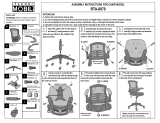
4
Explanation for list of points
Standard
Options
1. General
Thank you for choosing a wheelchair from Etac. The manual
must be read thoroughly to avoid damage when handling
and using the chair.
In this manual the User is the person sitting in the chair.
The Care giver is the person helping the user.
This symbol appears in the manual together with
text. It highlights actions where the wheelchair’s,
the user’s or the care giver’s safety can be put at
risk.
M100 is a manual, cross-folded, allround wheelchair with
variation options that is intended for use both outdoors
and indoors. Seat and footplates are adjustable in height
and angle, and the backrest in height. M100 can be
supplemented and adjusted if needs change. In addition
there is a range of options and accessories such as seat
cushions, anti-tips, various types of legrests and rear wheels
for example.
M100 has excellent prerequisites to create comfort, functio-
nality and good manoeuvrability.
Etac regularly improves its products. We therefore reserve
the right to modify the products without prior notice. The
dimensions given on drawings or other material are solely
for guidance.
We are not responsible for printing errors or incomplete
information.
Crash test:
Etac’s wheelchairs are tested in accordance with ISO
7176-19. They are crash tested at the Technical Research
Institute of Sweden. The tests were carried out with normal
settings on the wheelchairs (see manual for the respective
wheelchair) and with an UNWIN_WWR/ATF/K/R restraining
device and an UNWIN_WWR/HD/ATF/K/R 3-point seat belt.
Service life:
The product is tested and fulfils the demands stated in EN
12183. The main product’s durability and lifetime is at least
five years when used in accordance with intended use, the
safety instructions, the reconditioning manual and instruc-
tions for use in the user manual. The main product consists
of the chassis for seat and back support. Additional parts/
accessories are handled in accordance with the manual
and reconditioning manual. The actual lifetime can vary,
depending on how much and how intensively the product
is being used, but a maximum of 10 years. If the product
is intended for use after the service life period specified by
Etac, it is the responsibility of the product owner to ensure
product functionality in accordance with the manual and
reconditioning instructions. If this cannot be ensured then
the product should be taken out of use.
The following methods of surface treatment have
been used:
Lacquered surfaces = Polyester powder coating
Non-lacquered aluminium parts = Anodized coating
Non-lacquered steel surfaces = Galvanized
CE marking:
The product has passed all tests and met all criteria set by
European standards for specific product groups. Combina-
tion agreements exist, see www.etac.com
Guarantee:
5 year guarantee against material and manufacturing
defects. For terms and conditions, see www.etac.com
Special adaptations:
comprise everything that falls outside the instructions and
settings in this Manual. Wheelchairs specially adapted by
customers are not eligible for Etac’s CE marking. Etac’s
guarantee no longer applies. If in the least doubt about the
validity of adjustments, please contact Etac for advice.
Tests and Guarantees
Tools
In the centre spread of this manual you will
find a removable section that contains user
information.
CE marking
According to EN 12183
Read the operating instructions before use
To be sorted according to national regulations
Allen key Socket spanner Torx key
3, 5, 6 mm 19/24 mm T20
























